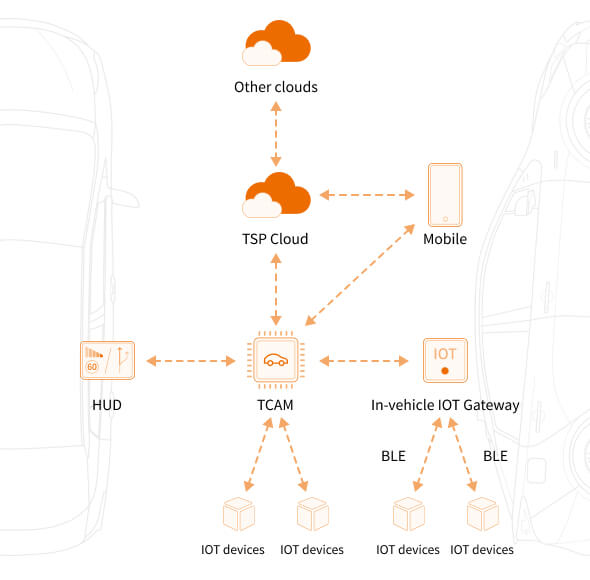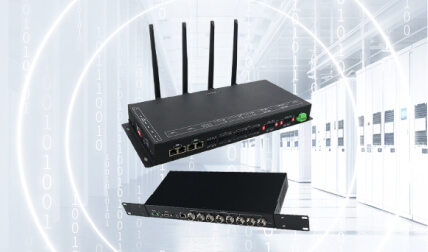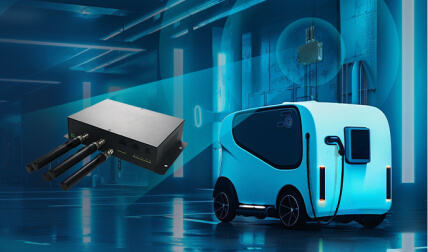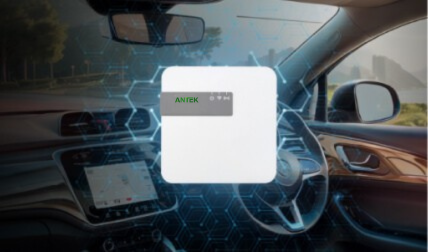Introduction to In-vehicle IoT Industry Solutions
In-vehicle IoT devices, as a bridge connecting the interior of the vehicle with external devices, are gradually becoming an important part of smart driving and smart cockpit. It can be used to control smart devices inside the vehicle, such as controlling the drone cabin to operate the drone, controlling the child seat (rotating, adjusting the angle, monitoring the baby’s status), etc .

In-vehicle Eco-hub: In-vehicle IoT Gateway


- The RV1106 solution that combines arithmetic power and cost-effectiveness can meet the requirements of adapting to environments up to 70 degrees
- The gateway connects to the TCAM via Wi-Fi, and connects to the in-vehicle IoT devices via BLE protocol
- The power supply meets the GB/T 28046.2 standard, which can be adapted to the in-vehicle power supply scenarios
- Small size and covert installation
One Stop OEM/ODM Services
ACCELERATE YOUR IOT GATEWAY LAUNCH FROM CONCEPT TO PRODUCTION
Professional R&D Capability, High Quality and Quick Response

Professional R&D
- Over 100 professionals with extensive IoT expertise.
- Efficient collaboration between R&D and production.
- Core algorithms and high versatility in industry-specific chip integration.
- Stable and reliable solutions reducing project R&D risks.

Rapid Manufacturing
- Streamlined design, manufacturing, and quality control. Shortened time-to-market and reduced development costs.
- 30 wave soldering lines, 8 testing lines, and 10 finished product assembly lines. Daily production capacity of 10,000 units.
- MES digital management system with unique QR code for each product.

Supply Chain Management
- Long-term partnerships with multiple mainstream chip manufacturers.
- Keeping abreast of technological advancements.
- Mature production lines ensuring fast and stable delivery.
- Lead times: 4 weeks for small batches (≤1,000 units), 2 weeks for baseline products (≤50 units).

Quality Assurance
- Certified to ISO14001:2015, ISO9001:2015, IATF16949:2016, and ISO45001:2018.
- Product testing includes DQA testing and laboratory certification.
- Utilization of quality management tools: FMEA, PPAP, ECN, SPC/CPK.
FAQ
Equipped with RV1106 processor (1.2GHz), running OpenWrt system, supporting 5~12V wide-voltage power supply (USB-C interface) to meet the dynamic voltage fluctuation in the car. RAM 128MB + Flash 32MB, lightweight design to ensure the stability of multi-device connection in the car (different from the high power consumption design of home gateway).
Dual-band Wi-Fi (2.4G+5G, 433Mbps) supports in-vehicle TCAM high-speed communication (e.g., 5G backhaul), BLE5 supports low-power IoT devices (e.g., tyre pressure sensors, in-vehicle refrigerator), and the second BLE port is reserved for expanding camping devices (e.g., outdoor lights, portable speakers), covering the full range of “Driving + Camping covering the whole scenario of ‘driving + camping’.
Switch by one key through physical network allocation key:
- In-vehicle scenario: long press network allocation key → gateway AP mode (2.4G hotspot) → DHU input the SSID password of TCAM → automatically connect to TCAM (STA mode);
- Camping scenario: long press network allocation key → Bluetooth broadcast → mobile phone APP input hotspot information → connect to mobile phone WiFi (STA mode).
Note: Support ‘Memory Networking’, next time you switch on the phone, it will automatically connect to the nearest network to avoid repeated settings.
Adopt ‘Priority Queue + Dynamic Bandwidth Allocation’: TCAM data (e.g. driving data) is prioritised for transmission (5G band), and BLE devices (e.g. child safety seat monitoring) use 2.4G low-latency channels to avoid bandwidth hogging by video monitoring and sensor data, and to support multiple devices to be online at the same time.
Antek’s in-vehicle IoT gateway is designed for dual scenarios of ‘driving + camping’
① Convenience of network distribution (one-button switching, memory function);
② Multi-device collaboration (vehicle/peripheral priority management);
③ Extreme environmental adaptation (wide temperature, low power consumption);
④ Data security (MQTT encrypted transmission, compliant with automotive-grade communication standards).
Suitable for fleet management, caravan modification, intelligent cockpit upgrading and other scenarios, solving the core problem of ‘unstable connection and single scenario’ of traditional in-vehicle gateway.
Through MQTT protocol, the gateway connects to the mobile phone hotspot, and then pushes the temperature of in-vehicle refrigerator and outdoor camera to the cloud in real time. For example, after the user gets off the car, the mobile phone APP can remotely check the status of the pets in the car, or control the external camping light through the gateway (the second BLE extension is required), which solves the pain point of ‘disconnecting from the network when leaving the car’ of the traditional in-car devices.
- Flexible Adaptation: Supports customised MQTT protocols (e.g. private cloud for automotive enterprises), compatible with mainstream in-vehicle protocols (e.g. J1939), allowing rapid secondary development by automotive enterprises;
- Eco-rich: Pre-integrated WiFi / Bluetooth drivers, saving 90% of the time for adaptation, suitable for front-end / rear-end installation market (the development cycle of a customised system is usually more than 2 weeks);
- Remote Upgrade: Pushes the firmware through the OTA to fix TCAM Remote Upgrade: Push firmware via OTA to fix TCAM compatibility issues (e.g. TCAM disconnection patch of a certain brand) without returning to the factory.
Professional R&D Capability, High Quality and Quick Response
Suitable for medium and large-sized robots, such as charging robots, cleaning robots, AGV (Automated Guided Vehicle)/AMR (Autonomous Mobile Robot), etc.

Energy Storage EMS Solution
It is compatible with container and distributed energy storage systems. It supports multiple protocols, ensures a stable connection, and enables integrated management.
Supports Wi-Fi and BLE (Bluetooth Low Energy) protocols, enabling docking with in-vehicle IoT wireless devices. It is compact in appearance and can be installed in a concealed manner.

Oil and Gas Industry Solution
Through a rich variety of interfaces, it connects various intelligent sensors and controllers in the scenarios of oil depot management.





